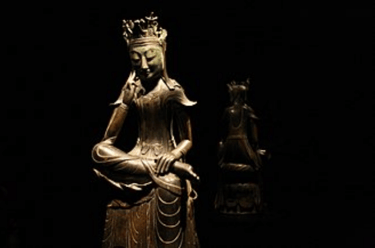National Treasure at LACMA
A harmonious image of idealism and realism, the Pensive Bodhisattva is depicted in a moment of deep meditation. Atop a circular lotus pedestal with a palmette pattern, Korean National Treasure #78 is the figure of a young boy. Smoothly silhouetted, his posture, unusually human for that of a Buddha statue, is quite complex. The seated figure crosses one leg over the knee of another pendant leg and supports a bent elbow of the corresponding arm, which, in turn, supports the head. The fingers of his raised arm press lightly against his cheek, his crowned head bent in introspection. Adorned by the complex and lavish sun and crescent-moon crown, his “oval face is full” and his profound expression is "gentle and calm,” realized by his masterfully rendered “thick eyelids, downcast eyes and downward head” (Lee 1981). Bent in concentration with a “quiet, yet intense presence” this treasure provides us with a glimpse into the everyday life and culture of ancient Korean society (The Metropolitan Museum of Art 1998). Graceful execution of the body portrays the relaxed subject as narrow, elongated, and flat. Treatment of the robe is shallow as well in its parallel folds. Drapery is fashioned in “step-folds” that “laterally flare out to the side in spiky, ‘fish-tail’ ends”(Lee 1981). Stylized, simplified, and schematic, the series of folds in his garments are separated regularly – “dignified and remote” (McCallum 1982).
Refined in beauty and proportion of design, this artifact creates a “rather vague picture of the full nature of the sculptural styles of the time” (McCallum). “Slenderness of the upper body and the arms” validates the belief that “at this stage, the sculptor was not especially concerned with representing the tangible volumes of the body” (McCallum).
Works Cited:
Lee, Junghee. "Sixth Century Buddhist Art." Korean Culture 2.2 (Fall 1981): 28-35.
McCallum, Donald. "Korean Influence on Early Japanese Buddhist Sculpture." Korean Culture 3.1, Spring 1982: 22-29.
The Metropolitan Museum of Art. Arts of Korea. Edited by Judith G. Smith. New York: Yale University Press, 1998.


